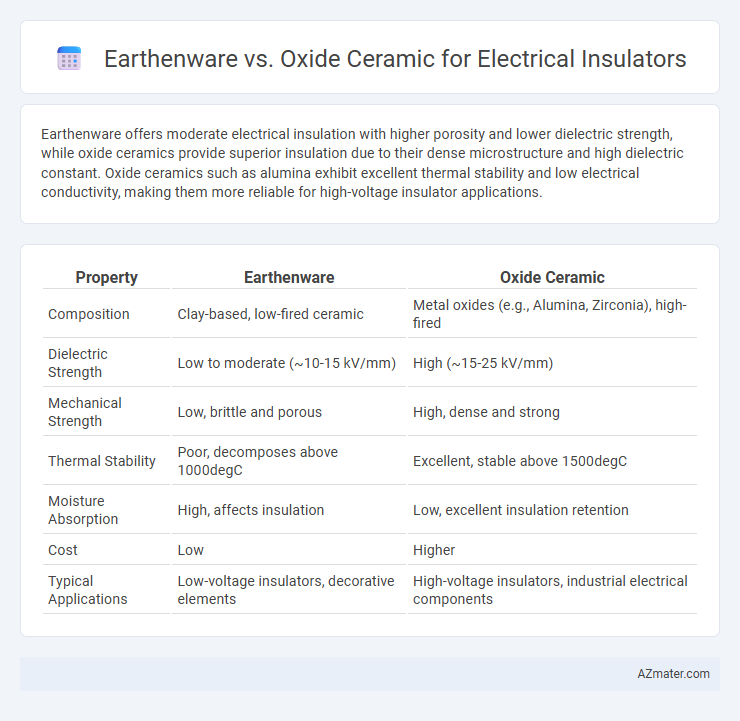Earthenware offers moderate electrical insulation with higher porosity and lower dielectric strength, while oxide ceramics provide superior insulation due to their dense microstructure and high dielectric constant. Oxide ceramics such as alumina exhibit excellent thermal stability and low electrical conductivity, making them more reliable for high-voltage insulator applications.
Table of Comparison
| Property | Earthenware | Oxide Ceramic |
|---|---|---|
| Composition | Clay-based, low-fired ceramic | Metal oxides (e.g., Alumina, Zirconia), high-fired |
| Dielectric Strength | Low to moderate (~10-15 kV/mm) | High (~15-25 kV/mm) |
| Mechanical Strength | Low, brittle and porous | High, dense and strong |
| Thermal Stability | Poor, decomposes above 1000degC | Excellent, stable above 1500degC |
| Moisture Absorption | High, affects insulation | Low, excellent insulation retention |
| Cost | Low | Higher |
| Typical Applications | Low-voltage insulators, decorative elements | High-voltage insulators, industrial electrical components |
Introduction to Electrical Insulators
Electrical insulators are essential components designed to prevent unwanted current flow and ensure safety in electrical systems. Earthenware and oxide ceramic materials both serve as effective insulators, with earthenware offering cost-efficiency and adequate performance in lower voltage applications, while oxide ceramics provide superior mechanical strength, higher dielectric strength, and enhanced thermal stability for high-voltage and industrial uses. The choice between these materials depends on the specific electrical, thermal, and mechanical requirements of the insulator in practical applications.
Overview of Earthenware Ceramics
Earthenware ceramics, made from natural clay fired at relatively low temperatures (usually 1000-1150degC), exhibit moderate porosity and dielectric strength, making them suitable for basic electrical insulation applications. Their mineral composition primarily includes kaolinite, quartz, and feldspar, which contribute to mechanical stability but limit high-frequency performance compared to oxide ceramics. Due to their lower firing temperature and inherent porosity, earthenware insulators are less resistant to moisture and electrical stress than oxide ceramics, restricting their use in high-voltage or harsh environmental conditions.
Understanding Oxide Ceramics
Oxide ceramics, such as alumina (Al2O3) and zirconia (ZrO2), exhibit superior electrical insulation properties and high dielectric strength compared to traditional earthenware materials. These advanced ceramics offer excellent thermal stability, chemical inertness, and mechanical durability, making them ideal for high-voltage electrical insulators and harsh operating environments. The controlled microstructure and high purity of oxide ceramics result in minimal electrical conductivity and enhanced breakdown resistance essential for reliable insulation performance.
Material Composition Comparison
Earthenware electrical insulators primarily consist of clay, silica, and feldspar, offering moderate mechanical strength and permeability to moisture, which can impact insulation performance. Oxide ceramics, such as alumina (Al2O3) or zirconia (ZrO2), feature a highly dense, crystalline structure with superior dielectric properties, thermal stability, and resistance to environmental degradation. The distinct material compositions result in oxide ceramics providing enhanced electrical insulation and durability in high-voltage and high-temperature applications compared to traditional earthenware.
Electrical Performance and Insulation Properties
Oxide ceramics exhibit superior electrical insulation properties compared to earthenware due to their higher dielectric strength and lower electrical conductivity, making them ideal for high-voltage applications. Earthenware, while more cost-effective, has lower dielectric breakdown voltage and higher porosity, which can lead to reduced performance in demanding electrical environments. Advanced oxide ceramics like alumina offer enhanced thermal stability and resistance to electrical degradation, ensuring consistent insulating performance over extended service periods.
Mechanical Strength and Durability
Earthenware insulators typically exhibit lower mechanical strength and durability compared to oxide ceramics, making them less suitable for high-stress electrical applications. Oxide ceramics, such as alumina and zirconia, offer superior mechanical properties including high compressive strength and excellent resistance to wear and thermal shock. These characteristics ensure greater longevity and reliability in harsh environments, positioning oxide ceramic insulators as the preferred choice for demanding electrical insulation needs.
Resistance to Environmental Factors
Earthenware insulators exhibit moderate resistance to environmental factors, including moisture and temperature fluctuations, making them suitable for low-voltage applications in stable climates. Oxide ceramic insulators, specifically alumina-based ceramics, demonstrate superior resistance to moisture, chemical corrosion, and thermal shock, ensuring reliable insulation performance in harsh and variable environments. The enhanced density and purity of oxide ceramics significantly reduce porosity and degradation, increasing longevity and electrical reliability under adverse conditions.
Manufacturing Processes and Cost
Earthenware electrical insulators are produced by shaping clay mixtures followed by low-temperature firing, resulting in porous and less dense materials suitable for low-voltage applications and lower manufacturing costs. Oxide ceramic insulators require more complex manufacturing involving high-purity oxide powders, pressing, and sintering at temperatures exceeding 1200degC, which yields superior mechanical strength, thermal stability, and electrical insulation but at a higher production cost. The choice between these materials balances the trade-off between affordability and performance, with oxide ceramics favored in high-voltage and demanding environments due to their enhanced reliability despite increased manufacturing expenses.
Applications in Electrical Systems
Earthenware insulators are commonly used in low-voltage electrical systems due to their cost-effectiveness and adequate dielectric strength, making them ideal for residential wiring and basic power distribution. Oxide ceramic insulators, such as alumina or zirconia-based ceramics, offer superior thermal stability, higher mechanical strength, and excellent electrical insulation properties, which are critical for high-voltage transmission lines, transformers, and substations. Choosing oxide ceramic over earthenware ensures improved performance in harsh environments, increased durability, and enhanced safety in complex electrical systems.
Conclusion: Choosing the Right Insulator Material
Selecting the appropriate electrical insulator material depends on performance requirements and environmental conditions; earthenware offers cost-effectiveness and good mechanical strength but lower dielectric properties, while oxide ceramics provide superior electrical insulation, higher thermal stability, and enhanced durability. For high-voltage or high-temperature applications, oxide ceramics like alumina are optimal due to their excellent dielectric constant and resistance to electrical stress. Earthenware is suitable for low-cost, low-stress environments, but oxide ceramics ensure reliability and longevity in demanding electrical systems.

Infographic: Earthenware vs Oxide Ceramic for Electrical Insulator
 azmater.com
azmater.com